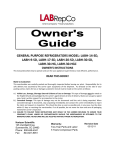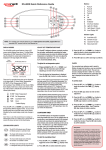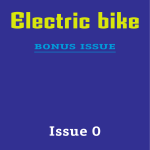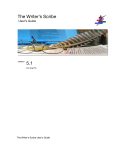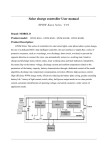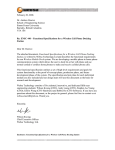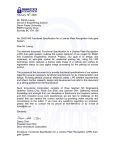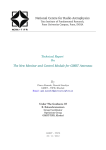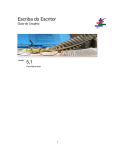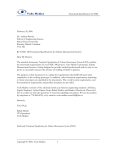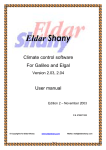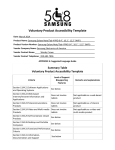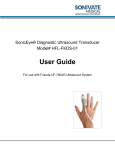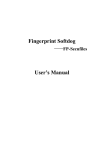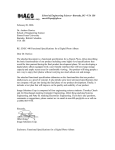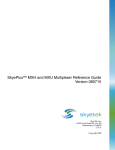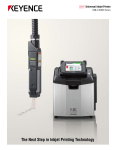Download Cover letter –Sieun, make a beautiful one please including a nice
Transcript
FUNCTIONAL SPECIFICATION FOR A WIRELESS ITEM LABEL LOCATOR (WILL) January 18th, 2008 Prof. Patrick Leung School of Engineering Science Simon Fraser University Burnaby, British Columbia. V5A 1S6 Re: ENSC 440 Functional Specification for the Wireless Item Label Locator (WILL) Dear Prof. Leung, The attached document describes the functional specification for the Wireless Item Label Locator (WILL) of The Third Eye (TTE), Ltd.. We aim to design and implement a system that consists of a remote and RFID item tags that will guide the user, particularly a vision-impaired one, to easily locate items. When the user presses a button on the remote, it will sense the location of the corresponding RFID tag, and make beeping noise of which the frequency indicates the tag proximity. The functional specification provides a set of high-level requirements for the system’s functionality for both the prototype and production phases of development. This document shall serve as the guideline and measure of the project progress to all members TTE. The Third Eye Ltd comprises of three innovative and ambitious engineering students: Tongxin Feng, Sieun Lee and Jieun Choi, who believe the role of technology is to create positive impact by enabling and empowering people. If you have any questions or concerns about our project, do not hesitate to call us at (604)779-6672, or email us at [email protected]. Sincerely, Tongxin Feng President and CEO Third Eye Ltd. Enclosure: Function Specification for a Wireless Item Labelled Locator FUNCTIONAL SPECIFICATION FOR A WIRELESS ITEM LABEL LOCATOR (WILL) THIRD EYE FUNCTIONAL SPECIFICATION FOR A WIRELESS ITEM LABEL LOCATOR (WILL) Project Team: Jieun Choi Sieun Lee Tongxin Feng Contact Person: Tongxin Feng [email protected] Submitted to: Patrick Leung – ENSC 440 Steve Whitmore – ENSC 305 Brad Oldham Jason Lee Issued date: February 18th, 2008 Revision: 1.8 FUNCTIONAL SPECIFICATION FOR A WIRELESS ITEM LABEL LOCATOR (WILL) Executive Summery In its 2001 report, A Profile of Disability in Canada, Statistics Canada identified 610,950 Canadians with a seeing disability. Those who have lost their vision speak of their loss of independence as they often must rely on help from others to carry out daily activities. With age-related macular degeneration as Canada’s leading cause of blindness and the increasing life expectancy, vision‐loss often accompanies common symptoms of aging such as loss of memory. Locating an item becomes a particular challenge not only for those with complete vision loss but also for the older people with partial vision loss. Commercially available item locators comprising of a remote and sound‐making item tags require the user to replace the tag batteries often. Consequentially, these have proved to be an unsatisfactory solution for a person with deteriorating vision, memory, and hand dexterity. The Wireless Item Label Locator (WILL) utilizes battery‐free passive radio‐frequency identification (RFID) tags. The remote is designed specifically to accommodate the needs of people with vision loss with special attention for those with old age. With the WILL, the user can press a button and locate the item by following the direction in which the remote makes faster beeping noise. Development of the WILL will occur in two phases. Upon completion of the first phase, the remote will be fully assembled and able to indicate whether or not a tag is within a given range. The range of detection will be within 1‐2 m. The user interface will have necessary components such as item buttons, power button, and volume control. The three‐month development cycle of this phase is targeted for completion on April 6th, 2008. For the second phase, the WILL will be capable of detecting the distance and orientation of the tag and indicate these by changing the rate of beeping. The range of detection will be within 1‐10 m. The user interface will be enclosed in a customized casing with tactile buttons and permanent braille embossing. The product package will include an audio manual, warranty, and sources for technical support. FUNCTIONAL SPECIFICATION FOR A WIRELESS ITEM LABEL LOCATOR (WILL) Table of Contents 1. 2. Introduction ......................................................................................................................................... 6 1.1 Scope ........................................................................................................................................... 6 1.2 Intended Audience ...................................................................................................................... 6 1.3 Classification................................................................................................................................ 6 System Requirements .......................................................................................................................... 7 2.1 System Overview ......................................................................................................................... 7 2.2 General Requirements................................................................................................................. 9 2.3 Physical Requirement ................................................................... Error! Bookmark not defined. 2.4 Electrical Requirements............................................................................................................. 10 2.5 Environmental Requirement ..................................................................................................... 10 2.6 Standards................................................................................................................................... 11 2.7 Reliability and Serviceability...................................................................................................... 11 2.8 Safety Requirements ................................................................................................................. 11 2.9 Performance Requirements ...................................................................................................... 12 2. 10 Usability Requirements .................................................................................................................. 12 2.11 3. 4. Luxury Functions........................................................................................................................ 12 Reader Requirement .......................................................................................................................... 12 3.1. General Requirements............................................................................................................... 13 3.2. Reader Physical Requirement.................................................................................................... 13 User interface Requirement............................................................................................................... 14 4.1 General Requirement ................................................................................................................ 14 4.2 Usability Requirements ............................................................................................................. 14 4. 3 Physical Requirements .............................................................................................................. 15 5. Tag Requirement..................................................................................................................................... 15 5.1 General Requirement ................................................................................................................ 16 5.2 Physical Requirement ................................................................................................................ 16 6. User Documentation............................................................................................................................... 16 7. System Test Plan ........................................................................................ Error! Bookmark not defined. 8. Conclusion .......................................................................................................................................... 17 9. References.......................................................................................................................................... 18 FUNCTIONAL SPECIFICATION FOR A WIRELESS ITEM LABEL LOCATOR (WILL) List of Figures Figure 2.1: System Block Diagram ............................................................................................................... 7 Figure 2.2: Commercialized Product Version 1 ........................................................................................... 8 Figure 2.3 System Overview.......................................................................................................................... 9 Glossary/Acronyms WILL Wireless Item Labelled Locator BIM Button Input Module SOM Speaker Output Module UIM User Interface Module CCM Central Control Module TIM Tag Identification Module RFCM Radio Frequency Communication Module RFID Radio Frequency Identification FUNCTIONAL SPECIFICATION FOR A WIRELESS ITEM LABEL LOCATOR (WILL) 1. Introduction The Wireless Item Labelled Locator (WILL) has the main function of helping people with vision‐loss with finding their everyday items such as wallets, bags, keys, etc. The RFID tags provide identification for each item it is attached to, and the remote detects and identifies the tags within a specified range. The product will benefit people with seeing disabilities and seniors with certain degree of vision loss. This document will outline the functions of WILL in more details. 1.1 Scope The document provides the functional requirements of the Wireless Item Labelled Locator for both the product and the prototype which is to be completed in April 2008. The subsequent sections describe further prototype development and improvement, along with production of the system. This document is also a future reference for our development guidelines. 1.2 Intended Audience The intended audience of the function specification are the members of The Third Eye team developing Wireless Item Label Locator. This document shall serve as the guideline and measure of the project progress to all members. It shall specify overall goals during the design phase and assessment criteria during the test phase. After the prototype is completed, the requirements in this document shall be the baseline in determining the completeness of the model and points of improvements. 1.3 Classification The following illustrated the conventions used throughout this document to denote functional requirements: [R#‐x] A functional requirement, where x is 1, 2 or 3 denoted as below: 1) A functional requirement for Phase 1 prototype development 2) A functional requirement for Phase 2 commercial product development 3) A functional requirement for both Phase 1 and Phase 2 development FUNCTIONAL SPECIFICATION FOR A WIRELESS ITEM LABEL LOCATOR (WILL) 2. System Requirements The information provided in this section is intent to give the audience the basic configuration of our Wireless Item Labelled Locator, and a comprehension for the overall system. 2.1 System Overview The WILL system can be described in overall system flow as shown in Figure 2.1. Input User press button to indicate item ID Output Remote looks for tags with requested ID Tags within range respond to reader Remote identifies the tags Output sound when correct tag is identified Figure 2.1: System Block Diagram There will be differences between the proposed commercial product and our first prototype because of the limitations on time, budget, and amount of labours available. The basic functions in the prototype will allow the user to select the item s/he wants to find, and the remote will indicate whether the item is nearby or outside defined range from the user by beeping sound. The tags will be attached to the items, which the user wants to keep track of using the WILL. The figure below is an overview of the commercial product. The advanced features will estimate the distance between the tags and the remote, with varying beeping frequency as the indicator; also a security tracking function will notify the user when a tagged item is removed outside of a specified range. FUNCTIONAL SPECIFICATION FOR A WIRELESS ITEM LABEL LOCATOR (WILL) Antenna Node for controlling sensitivity User Name ON/OFF button User A WALLET Tag WALLET Braille KEYS KEYS 7‐15 mm BAG 20‐50mm BAG Customizable label with LED background Buttons Speaker Figure 2.2: Commercialized Product Version 1 The remote interface will output beeping sound rather than voice to indicate when the item is within the range; this will consume less battery power and reduce the maintenance cost. Many of the potential users of this product are possibly forgettable, and by using passive tags, we completely FUNCTIONAL SPECIFICATION FOR A WIRELESS ITEM LABEL LOCATOR (WILL) eliminates the requirement to remember to replace the batteries for the tags like other products in the market, and the user does not have to change the batteries for the remote very often either. The users will attach the tags to the items they want to track. One tag assigned to one button on the remote. When the user wants to find a tagged item, s/he simply presses the corresponding button. The example below describes how the WILL works. Mary attaches the green tag to her key. One day, she misplaces her key. In this case, Mary finds the WILL remote, turns it on and presses the green button with the label KEY and a Braille number. She walks to where she guesses the key may be; when the remote starts beeping, Mary knows the key is nearby (1‐2 m for the prototype), and she can start searching. The prototype shares the same basic functions with the commercial product. The difference will be the detection range; the prototype will detect within 1‐2 meters whereas the commercial product will do so within 1‐10 meters. Also, the product remote can indicate to the user whether they are moving toward the item or away. The remote will beep faster when it gets closer to the item. It will beep slower when it gets farther. An advanced feature of security tracking may be also implemented on the commercial product version, so the user will turn the remote on, and any tag that is moving out of a certain range will trigger the alarm. The overview of how the WILL works is shown in Figure 2.3. Figure 2.3: System Overview 2.2 General Requirements [R 1‐3] The system must have an off state where there is no activation from either the remote or tag. [R 2‐2] The user shall be able to stop the beeping sound at anytime. FUNCTIONAL SPECIFICATION FOR A WIRELESS ITEM LABEL LOCATOR (WILL) [R 3‐2] The retail price shall be under $150. 2.3 Electrical Requirements [R 4‐1] The remote unit shall be powered by one 9V battery, pp3 battery. [2] [R 5‐2] The reader/user Interface shall be powered by common AA batteries [R 6‐3] The tags shall not require any external power source [1] [R 7‐3] The Reader/User Interface shall be turned off and disconnected from the power source after 10 minutes of no activity. [R 8‐3] The Reader/User Interface shall be turned off and disconnected from the power source after 40 minutes of no interrupt received even if it is still receiving signal from tag and beeping. [R 9‐3] The reset shall be implanted on the reader/user Interface which turns off the whole system down. 2.4 Environmental Requirement [R 10‐3] The unit shall be capable of operating at the normal temperature from ‐7oC to 41oC [R 11‐3] The unit shall be able to operating under all domestic pressure and humidity ranges [R 12‐3] The unit exterior cover will not excel 37oC under normal conditions [R 13‐3] Remote control case should be durable enough to withstand physical shock such as dropping [R 14‐3] The system shall be operated under no other radio frequency interference. [R 15‐3] The system shall not be operated where equipments with UHF is used. [R 16‐3] The system shall be used in non hazardous indoor area where the user is familiar with. [R 17‐3] Any electrical wiring shall be enclosed. FUNCTIONAL SPECIFICATION FOR A WIRELESS ITEM LABEL LOCATOR (WILL) 2.5 Standards [R 18‐3] The WILL shall follow the ISO wireless communication standard[6] [R 19‐3] The WILL shall meet 25 directives including low‐voltage equipment to achieve CE mark in Europe[6] 2.6 Reliability and Serviceability [R 20‐3] Electronic components shall act normally under their operating conditions [R 21‐3] Speaker shall never be turn on higher than ear damage level, 120 decibels. [3] [R 22‐3] Speaker shall be turned off when on/off button is pressed or batter is lost. [R 23‐2] Battery life shall last longer than 6 months. [R 24‐3] Tag shall be resistible to liquid damage or certain amount of pressure. [R 25‐3] Tag shall be resistant to ordinary level of band or folding. [R 26‐3] Tag shall be resistant to everyday life’s level of scratch [R 27‐3] Adhesive on tag shall not be melt in room temperature [R 28‐3] Adhesive on tag shall not be melt in room humidity [R 29‐3] Thick plastic coat on the outside surface of the tag shall be used. [R 30‐3] Several tag for each item shall be provided in case it has to replaced. [R 31‐3] The locator shall have a reset button to go back to factory mode. 2.7 Safety Requirements [R 32‐1] The locator unit shall be hold properly levelled, with no hard pressing, swinging, or knocking [R 33‐3] The remote shall have a container which is resistance to electrical shock. [R 34‐3] The remote shall have a battery holder enclosed inside. FUNCTIONAL SPECIFICATION FOR A WIRELESS ITEM LABEL LOCATOR (WILL) [R 35‐3] The buttons shall be tightly plugged the reader/user interface, so to minimize the liquid penetration. [R 36‐3] Any part of the Reader/User interface shall not have any sharp edge or part that causes body harm. [R 37‐2] WILL shall provide Industry‐leading privacy protection [R 38‐2] WILL shall provide anti‐counterfeiting/anti‐tampering 2.8 Performance Requirements [R 39‐1] The read/user interface shall be playing beeping sound to indicate to the user the item is found [R 40‐2] The product shall be able to modify the output sound to indicate to the user the distance. [R 41‐1] The prototype unit shallbe able to read within a range of 1‐10 meters and detect tags within range of reader [1] [R 42‐2] The product unit shall be able to read tags within a range of 1‐ 10 meters and estimate the distance of the tag by varying the reader/user interface reading range 2. 10 Usability Requirements [R 43‐2] Online guide with audio or simple trouble shooting guide in the user manual required. 2.11 Luxury Functions [R 44‐3] User can select different sound for different item 3. Reader Requirement The Reader/User interface has functions described below: • To allow the user to choose which item s/he is looking for. FUNCTIONAL SPECIFICATION FOR A WIRELESS ITEM LABEL LOCATOR (WILL) • To identify the tag attached to chosen item. • To activate the tag • To indicate the user to item is nearby • To indicate the user how close the item is The size of the reader/User interface is important factor. 1. It should be portable and easy to hold with one hand 2. It should be large enough to put label and the button for vision‐impaired and senior users. 3.1. General Requirements [R 45‐3] The Locator unit shall have at least three buttons, on/off switch, and buzzer volume control switch. [R 46‐3] All the switches, buttons shall be located on top surface of the reader/user interface [R 47‐3] The Locator unit shall have battery holder which has minimum required size for the battery. [R 48‐3] The Locator unit shall have the turn off battery holder which has minimum required size for the battery 3.2. Reader Physical Requirement [R 49‐1] The length of the reader/user Interface should be longer than 70mm and shorter than 200mm. [1] [R 50‐1] The width of the reader/user Interface should be longer than 85 mm and shorter than 200mm. [2] [R 51‐1] The height of the reader/user Interface should be longer than 20mm and shorter than 50mm. [3] [R 52‐3] The height of the reader/user Interface on the battery part should be longer than 20mm and shorter than 50mm[2] [R 53‐1] The reader module shall be customized to smaller size and less thick as possible. FUNCTIONAL SPECIFICATION FOR A WIRELESS ITEM LABEL LOCATOR (WILL) [R 54‐3] The weight of the Reader/User interface should not exceed the range in which an adult cannot hold it with one hand. [R 55‐3] The shape of the Reader/User interface should be comfortably designed for an adult to hold it with one hand. 4. User interface Requirement The user interface unit shall consist of a set of buttons as inputs, which will be connected to the processing unit. The user interface shall also include display elements as outputs. The user interface unit shall maximize accessibility for multiple users.[5] Vision loss often results from aging. Therefore, it is essential that the user interface unit accommodates following needs: • Complete vision loss • Partial vision loss • Memory problem • Hearing problem • Hand manipulation problem 4.1 General Requirement [R 56‐3] The user interface unit shall have a set of push‐buttons corresponding to the tags. [R 57‐3] The user interface unit shall have a buzzer volume control switch. [R 58‐3] The user interface unit shall have a power on‐off switch. [R 59‐3] The primary means of user input shall be through the buttons and the power switch. [R 60‐2] The outputs on the user interface unit shall consist of LED on the buttons to indicate which button has been pushed. [R 61‐1] The power on‐off switch shall a rocking type that the user can tactilely check the status of the device. [R 62‐3] The user interface unit shall allow the user to select the tag to locate and to stop the buzzer sound manually. FUNCTIONAL SPECIFICATION FOR A WIRELESS ITEM LABEL LOCATOR (WILL) 4.2 Usability Requirements [R 63‐3] Item buttons shall be large for easy use and provide space for labelling. [R 64‐2] Removable button labels shall be provided with the device. Item buttons shall be easily differentiable: [R 65‐2] The buttons shall be color‐coded with LED backlighting. [R 66‐2] The buttons shall have tactile edges. [R 67‐2] The buttons shall have permanent braille label. 4. 3 Physical Requirements [R 68‐3] The item button width shall range in 6‐10 cm. [6] [R 69‐3] The item button length shall range in 2‐5 cm. [R 70‐3] The item button height shall be maximum 7 mm when the button is pressed and maximum 15mm when the button is not pressed. [R 71‐3] The volume switch wheel shall range in 5‐10 mm in width and 30‐50 mm in length. [R 72‐3] The power switch shall be in 15 – 25 mm in width and 35 – 50 mm in length. The elevated part of the switch shall be maximum 20 mm in height. [R 73‐3] The buttons and switches shall be easily pressed, un‐pressed, or turned. 5. Tag Requirement A tag is attached to the item which users want to find. When the reader is activated to find this item, the tag will responds to the reader when it is in the readable range. There are two important factors in tags • The size • Durability FUNCTIONAL SPECIFICATION FOR A WIRELESS ITEM LABEL LOCATOR (WILL) The size of the tag matters because usually the item is a small object which can get easily lost in clutters or small hidden space. And the durability of the tag is important because some of the item is used daily and has lots of physical contact. 5.1 General Requirement [R 74‐3] Tag shall be placed on non liquid objects [R 75‐3] Tag shall be colour ‐coded according to the user interface buttons 5.2 Physical Requirement [R 76‐3] Tag size shall be as small as possible. [R 77‐2] Tag size shall be customized for different item. [R 78‐2] Tag design shall be customized such as sticker type, key chain type and others. [R 79‐2] Tag shape shall be customized for different item 6. User Documentation [7] [R 80‐2] User document shall include a website with general and technical support information and the electronic version of manual. [8] [R 81‐2] The website shall be in simple HTML format and compatible with available text‐to‐speech software. [9] [R 82‐2] Audio user manual shall be provided with the product. [R 83‐2] Print user manual shall be in large‐print English and braille English. [R 84‐2] User manual shall include a section on maintenance and troubleshooting. [R 85‐2] All documentation shall contain the company’s contact information and immediate assistance and troubleshooting shall be available by phone upon request. FUNCTIONAL SPECIFICATION FOR A WIRELESS ITEM LABEL LOCATOR (WILL) [R 86‐2] Warranty and replacement shall be included in the user manual. 8. Conclusion The functional specification clearly defines the capabilities and requirements of the WILL. Development of the final production device will take place in two distinct phases. All functional requirements outlined above applying to the prototype (marked with 1 or 2) are expected to be completed by the target date of April 6th, 2008. FUNCTIONAL SPECIFICATION FOR A WIRELESS ITEM LABEL LOCATOR (WILL) 9. References [1] Sketeck, [Online]. Available: http://www.skyetek.com/Portals/0/Documents/Products/SkyeModule_M9_DataSheet.pdf [Accessed: February 16th, 2008] H H [2] Wikipedia.com, 9V Battery, [Online]. Available: http://en.wikipedia.org/wiki/9_V_battery [Accessed: February 9th, 2008] H H [3] Wikipedia.com, Sound Pressure, [Online]. Available: http://en.wikipedia.org/wiki/Sound_pressure [Accessed: February 10th, 2008] H H [4] Wikipedia.com, CE Mark, [Online]. Available: http://en.wikipedia.org/wiki/CE_mark#_note‐0. [Updated: February 6th, 2008] H H [5] Tobias, Jim, Information Technology and Universal Design: An Agenda for Accessible Technology. Journal of Visual Impairment & Blindness, October 2003 [6] Standard Multi‐Purpose Label Size http://www.staples.ca/ENG/Catalog/cat_skuset.asp?CatIds=5%2C70,73&name=CA%5FSK%5FSTAPL ES+Business+Depot+%2D+Multi%2Dpurpose+Labels [7] Eldar, R. Easier Living With Assistive Technology, Assistive Technology ‐ Added Value to the Quality of Life, IOS Press, The Netherlands, 2001 [8] Fruchterman, James R. In the Palm of Your Hand: A Vision of the Future of Technology for People with Visual Impairments. Journal of Visual Impairment & Blindness, October 2003 [9] Lellmann, Jan. Free Text‐to‐Speech Software. http://members.iinet.net.au/~simonh/spacejock/yRead.html, Germany, 2008 H H


















